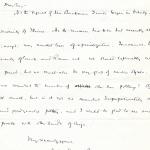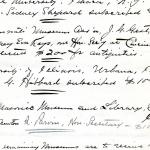Urbana-Champaign, IL, University of Illinois
Current name(s) of destination(s):
Urbana-Champaign, IL, Spurlock Museum, University of Illinois
Country:
Destination category:
Institution
Institutional history:
The Spurlock Museum traces its origins to a pair of cultural museums established by the University’s Board of Trustees on July 8, 1911: the Museum of Classical Archaeology and Art and the Museum of European Cultures. They were located on the 4th floor of the newly-built Lincoln Hall on the University Quadrangle. In 1917 an “Oriental Museum,” joined the other two, primarily to focus upon the civilizations of the Ancient Near East, Mesopotamia and Egypt.
Notes on distribution:
According to the Egypt Exploration Society distribution lists the following were allocated to the University of Illinois:
From Atfieh, Ptolemaic Period
Graeco roman branch objects specially requested. The complete outfit of a mummy in the Ptolemaic period consisted of 5 pieces of cartonnage, a head pieces, a pectoral, a stomach piece, a leg piece, and a footcase, all of which were placed outside the wrappings of the mummy, and fastened on either by sewing or with narrow ribbons of mummy cloth.
From Taieba, Ptolemaic period
Beads; 3 fragments Coptic coffins
Pottery, general selection.
In an email to ALice Stevenson in August 2012, Amy P. Heggemeyer (Assistant Registrar for Acquisitions) advised that: "the Spurlock Museum houses 718 objects sourced to the Egypt Exploration Society. According to our records, 346 objects were donated between 1911-1915.
The donations were made to the University of Illinois Classical Museum, which merged with other campus museums into the present Spurlock Museum. According to our records, the donations arrived at the museum primarily through the efforts of Mrs. William Gold Hibbard, Jr. of Chicago, a subscriber to EEF.
The donations made to the Classical Museum were assigned the following accession numbers. You can search our online database by accession number to retrieve artifact records with images of varying quality (we are working to update images). The online database is found here: http://www.spurlock.illinois.edu/search/index.php
According to our records, the donations are associated with the following sites:
1911.02: (64 records) Abydos, Naukratis, el-Sawam'a, Bellabesh
1912.01: (58 records) Abydos, Taieba, Naukratis, Antinoe
1914.05: (192 records) Abydos, Antinoe, Oxyrhynchus
1914.2: (30 records) Oxyrhynchus
1915.01: (3 records) Antinoe
An additional 9 objects with the accession number 1900.38 were acquired at an unknown date, and therefore may be related to your research interests. These "Found in Collection" objects are associated with Oxyrhyncus and Naukratis".
Information from http://w2.spurlock.illinois.edu/about/history/ [accessed 14 January 2016] 1923—Albert T. Olmstead (Professor of Ancient Near Eastern History) purchases the painted wall fragment from Pharaoh Akhenaten’s palace at el-Amarna from the Egypt Exploration Society for $500. It becomes a centerpiece of the Oriental Museum’s collection. A newly appointed Instructor, Dr. Franklin P. Johnson, was appointed curator in 1924. His name appears in two letters from Egypt Exploration Society Archives in London, both from Marie N. Buckman, secretary of the Boston Office, to Miss Jonas, secretary of the London Office (Nov. 12, 1925 and December 1, 1925). He was involved with the acquisition of the 1926 materials from the Egypt Exploration Society). He was curator either for two or three years and left the university after the 1926-27 academic year.
Related archive documents
Destination location:
See also:
Excavations from which artefacts are distributed:



